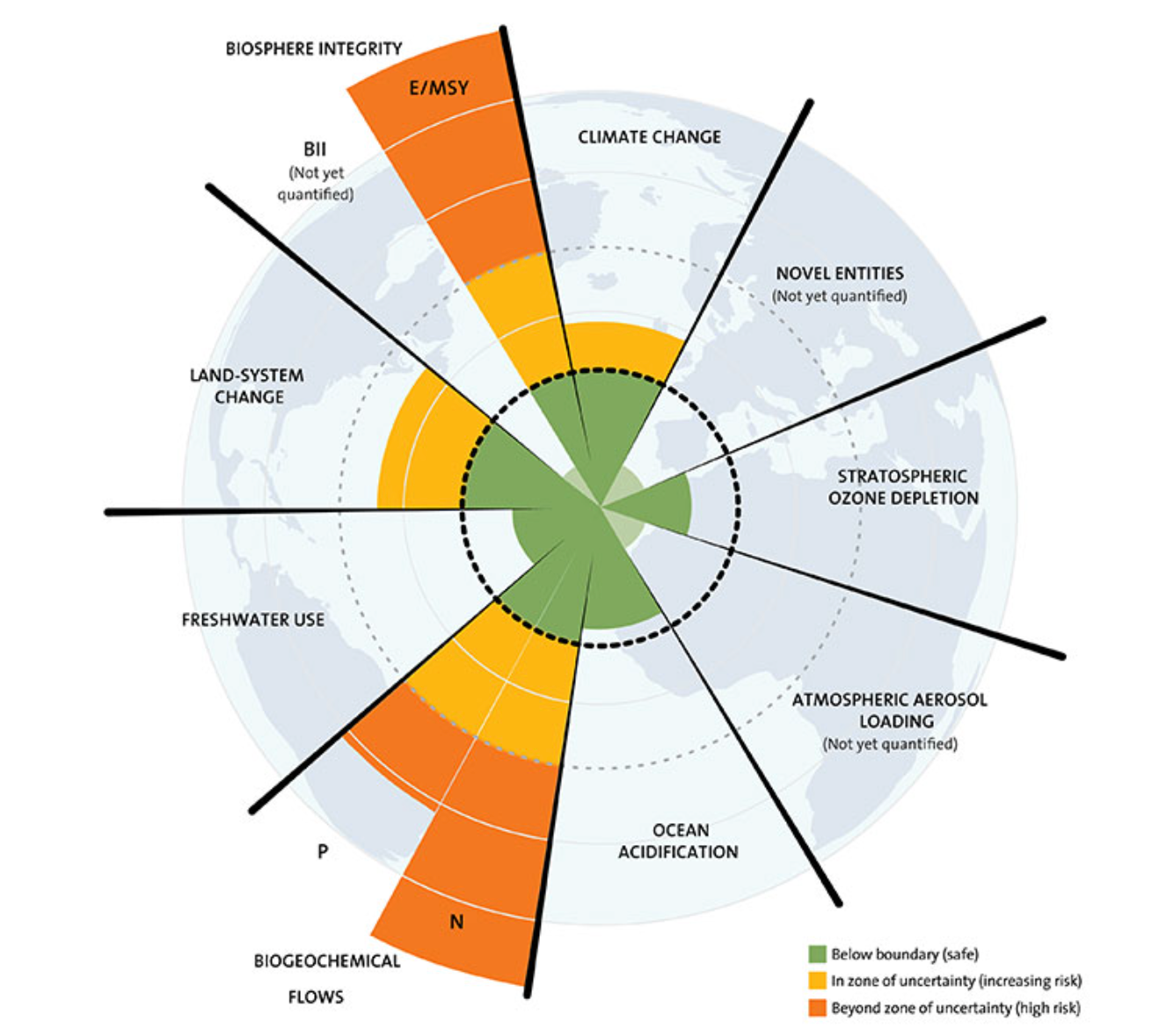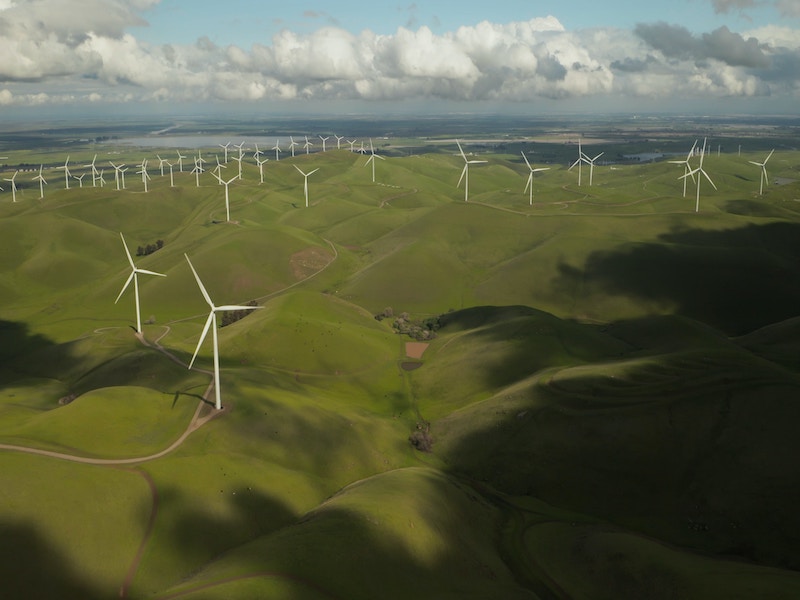The goal of net zero hides an inconvenient reality
Achieve net zero by 2050, and we’ll restrict global warming to 1.5°C. Restrict global warming to 1.5°C, and we’ll avert the worst impacts of the climate crisis. So if we do achieve the goal by 2050, would that make society sustainable? It sounds like a silly question. If the problem is global warming, and the solution is net zero, then surely reaching a point where the solution is implemented will mean we resolve the problem? Well, not quite. The inconvenient reality is that climate change is just one of nine critical biophysical processes identified in the Planetaries Boundaries framework. The framework was developed by a group of Earth system scientists, the aim was to “define a safe operating space for human societies to develop and thrive, based on our evolving understanding of the functioning and resilience of the Earth System.” The safe operating space is, in essence, what environmental sustainability looks like. It defines a space we must operate within to maintain the conditions of the Holocene.
The image of the nine planetary boundaries shows the safe operating space in the middle — this is where each process must remain to maintain the stable conditions of the Holocene. Positive feedbacks are drivers of change that risk moving a process outside of the safe space. If this happens, the process breaches a boundary and enters the zone of uncertainty. The further the process is driven from the boundary, the greater the risk of triggering tipping points and moving a process into an unknown state.

The framework defines where the boundary lies between the safe operating space and the zone of uncertainty. In doing so, it translates into goals for what needs to be done to either move a process back into the safe operating space or to make sure it stays there. For example, to move climate change back within the safe operating space, atmospheric concentrations of CO2 must remain below 350 ppm. Efforts to do that revolve around reaching net zero.
Climate change is a core planetary boundary through which other boundaries operate. This means actions that seek to reduce the impacts of climate change can have positive knock-on effects. For example, with less emissions, the ocean will absorb less carbon dioxide, helping to reduce the impacts of ocean acidification. But none of the other planetary boundaries have been integrated into a legally binding agreement. This neglects the fact Earth is a complex non-linear system made up of various processes that interact to form the environment. The food system highlights the issue.
Creating a sustainable food system is critical for several reasons (outside of the fact humans depend on food to survive). The food system is intertwined with various ecological impacts, like habitat destruction (which leads to biodiversity loss), land system change, and increasing concentrations of nitrous oxide and phosphorus. Industrial-scale bottom trawling is right up there in terms of devastating environmental impacts. The practice involves raking the seabed with enormous nets that suck all life from the sea floor, including up to 41 percent of invertebrates. On top of this, bottom trawling is enormously wasteful. In the 64 years between 1950 and 2014, it’s estimated 437 million tonnes of fish, worth $560 billion in revenue, were thrown back into the ocean as by-catch.
The EU has banned bottom trawling at depths of more than 800m. There were talks of taking things a step further by banning bottom trawling in marine protected areas. In response, the European Bottom Fishing Alliance (EBFA) was formed, uniting fishing associations in 14 countries, to push back against any proposed ban. The industry provides 35 million tonnes of annual fish catch. So banning it would lead to fewer fish being caught, increasing fish prices. But research suggests the economic benefits would quickly outweigh the costs, while banning the practice would allow ocean habitats to recover. While it would seem there are multiple benefits of banning the industry, the EBFA claim bottom trawling is sustainable due to certification schemes such as the one run by the Marine Stewardship Council. This rather questionable claim is understandable when the EBFA’s interests lie in the industry continuing regardless of the consequences to the environment.
The short-term desire to maintain low prices continues to outweigh the devastating long-term environmental consequences, showing that our priorities are misaligned with the reality of our actions. There is no unifying vision of what a sustainable food system looks like. So self-interested governments and companies will continue resisting calls to ban destructive industries if they benefit economically from maintaining them. That bottom trawling remains a thriving industry illustrates where we’re at when it comes to limiting the impacts of biodiversity collapse. Efforts to mitigate biodiversity collapse revolve around The Aichi Biodiversity Targets, drawn up by the Convention of Biological Diversity. They list five strategic goals that need to be achieved to prevent or at least reduce the risk of catastrophic biodiversity collapse. But, there is no legally binding framework, and it’s also unclear how the Aichi Biodiversity Targets feed into net zero or other environmental initiatives. It leads to blind spots and actions being taken in isolation from one another.
Focusing on the net zero target neglects all of the other planetary-scale impacts. And this is before we even get to the social side of sustainability. It’s no good reaching a point where we have low carbon emissions if one person in nine doesn’t have enough to eat. One in four lives on less than $3 a day, one in three still has no access to a toilet, and one in four has no source of safe drinking water. Efforts to end poverty revolve around stimulating economic growth in developing countries and creating a rising tide that raises all boats. The idea is that by following the same development path as in the West, that rising tide will lead to increasing incomes, allowing more people to provide for their needs. But there is a conflict of interest between how we conceive of social development and environmental impacts.
In Prosperity without Growth, Tim Jackson imagines a scenario where creating a just world is taken seriously, and global incomes converge by 2050. For that to happen, if rich countries grow at two percent each year, middle-income countries would need to grow around 7.6 percent each year, and low-income countries by almost 12 percent. In this hypothetical world, that would mean that by 2050 the global economy will be 11 times bigger than in 2016. Beyond 2050, if incomes continue increasing by two percent each year, the economy will be 30 times larger by the end of the century.
We would need 1.7 Earths to make our consumption habits sustainable. So at a time when our demands on resources and energy need to decrease, what would our impacts look like if the economy is 30 times larger? Without decoupling economic growth from environmental impacts, a scenario that has been proven to be impossible, an economy 30 times larger than today is self-evidently impossible, because our resource and energy inputs will have to increase enormously. Ecological processes will be driven further away from the safe operating space, increasing the risk of triggering tipping points that will transform the natural world into an unforgiving new state. If this future hypothetical world sounds far-fetched, consider that global economic output is expected to grow by three percent per year until 2050.
Efforts to end poverty just aren’t a priority because developed nations aren’t directly impacted by it. If anything, globalisation in its current form works rather nicely as it is. Rich nations benefit from cheap consumer goods, while developing nations deal with the pollution caused by production. With this conflict of interest in mind, let’s get back to our scenario where we’ve reached the goal of net zero by 2050. What might have become clear is that the goal is unfit for purpose. Reaching net zero is purely a hypothetical scenario anyway because we’re no way near being on track to meet the target. Based on current commitments, the world is on track for 2.7°C of warming by 2100. The Emissions Gap Report 2022 argues there is no credible pathway to achieving the 1.5°C target, and climate disaster can only be avoided by an urgent system-wide transformation. The bottom line is that net zero is a Western target that suits the Western agenda.
This belief that all we need to do is achieve net zero and seemingly all of our problems will blow in the wind is dangerously misguided. But the goal is interwoven with a myth everyone wants to believe to be true — current living standards are sustainable, all we need to do is become more efficient in how we use energy. Given how large the economy would need to be if everyone had the same living standards, development of the Western kind is self-evidently not sustainable. And that’s precisely why achieving net zero has become synonymous with sustainability, because it creates an illusion that it is.



